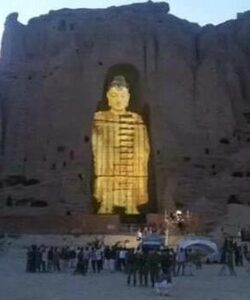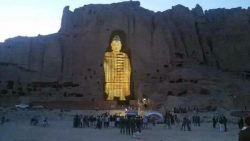Keeping Your Cool
In A Taliban Kind Of World
I recall the day at St. John’s College Santa Fe when news reached the Western world that the Taliban had blown up the two standing Buddhas carved in a cliff in the Bamiyan valley of Afghanistan. We had been reading Buddhist literature as part of the St. John’s College Eastern Classics program, and as we took our seats around a classroom table one of us reported the Taliban’s outrageous act. The seventh-century giants were destroyed. Our faculty moderator taking his seat shrugged off the news with a few words about “non-attachment.”

We had discussed attachment as a Buddhist moral term, not as a common social term like the attachment of two lovers or friends. With regard to the rich, some of us had concluded that it was okay to collect stuff as long as you are not attached to it, like a hoarder. And in my interpretation of Buddhist meditation I had observed that you can mentally override attachment — circumvent habitual thinking about things and persons including your own fictitious self. In effect, you renounce consumerism and possessive or jealous relationships. . . . At least as you sit still in silence, crosslegged, overcoming the five “hindrances:” hate-lust, depression-restiveness, and doubt. You loosen the bonds of envy, shame, grief, regret, and so forth for maybe 45 minutes until a gong resonates. That still is my interpretation of non-attachment. It is a tactic I have employed against some terrible losses. I’m aware of the classification “disassociation” disorder in the old Diagnostic and Statistical Manual of Western psychology, but it’s not the same as detachment.
One of my authorities for contemporary Zen practice now is Christian Dillo, who was a teacher at the Crestone Mountain Zen Center for 20 years before moving to Boulder. He is of the Soto lineage that began in the Sixties in San Francisco with the Japanese immigrant Suzuki Roshi and continued through the American Richard Baker. Dillo Roshi has just published what he calls a handbook on Zen practice. (The Path of Aliveness, 2022, Shambala Publications of Boulder CO.) Some of his dharma talks in Crestone that I attended have inspired chapters in the book. For example, take his basic rules for sitting in meditation (zazen). Don’t move, don’t scratch and “don’t invite your thoughts to tea.” It is a perfect metaphor to the process of non-attachment.
So, now back to shrugging off the Bamiyan Buddhas — and how they relate to Dillo Roshi’s book. Gary Snyder in his collection of poems “Danger on Peaks” narrates his feelings about the sandstone violence by the “woman-and-nature-denying” authoritarians. He quoted a contemporary poem by Dennis Dutton:
- Not even
- under mortar fire
- do they flinch
- The Buddhas of Bamiyan
- Take Refuge in the dust
A Buddhism expert wrote to him that “Well, yes, but” all things decay. He answered, “Ah yes. . . impermanence” but added this is never a reason “to pass off the sufferings of others because they are merely impermanent beings.”
Another correspondent said that “the foolish veneration for holy places and holy texts” is an obstacle to “respect for human life and culture.” Snyder responded, “The Bamiyan statues are part of human life and culture, they are works of art, being destroyed by idolators of the book.”
Five months later he would write: “The men and women who died at the World Trade Center together with the Buddhas of Bamiyan, take refuge in the dust.”
His whole narrative poem centers on a haiku by the Japanese classic poet Issa:
- This dewdrop world
- is but a dewdrop world
- and yet —
That ‘and yet,’ Snyder said, “is our perennial practice” and maybe the root of Buddhist teaching.
He discussed this haiku sometime later in Boulder, and Christian Dillo was in the audience. He writes in his book: “These two simple words — and yet — can move me to tears at almost any time. . . . that everything is so fragile is what makes everything so beautiful and precious.”
He quoted his spiritual grandfather, Suzuki Roshi: “That we are attached to some beauty is itself Buddha’s activity. . . If you know this, it is all right to attach to something. If it is Buddha’s attachment, that is non-attachment.”

